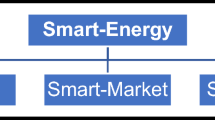Abstract
This paper presents a business model guideline of electricity utility systems based on blockchain technology in Thailand: a case study of consumers, prosumers and SMEs. Because the resource management of electricity utility systems in Thailand presently are based on enhanced single buyer or a centralized system. However, a free-trade energy market is likely to open or occur in the near future. Thus, a preparation of changing or adapting such a free-trade energy market using disruptive technology is an important point to study the aforementioned disruptive technology (i.e. blockchain technology). The future business of the free-trade energy market is related to the policy of the government (Thailand 4.0). It will support technology development and innovation to encourage the potential and readiness and to compete for foreign countries. In this scoping study, the business model guideline of electricity trading with peer to peer (P2P) is proposed to utilize the case study of consumers and prosumers/SMEs in Thailand based on a decentralized system. The P2P trading is directly the buying and selling of electricity between both consumers and prosumers. It is not a passed intermediary; otherwise, an intermediate process can be cut by this trading in order to save and reduce electricity costs. Preliminary expected impacts of cost structure analysis are summarized in terms of comparisons between the existing electricity trading and the blockchain technology. The results of such preliminary expected impacts show that costs to consumers, prosumers and SMEs obtained from the use of blockchain technology are possibly lower than those of EGAT, PEA, and MEA in the future. In addition, the business model guideline is completely discussed by theory in disruptive innovation.








Source: Clayton M. Christensen, Michael E. Raynor, and Rory McDonald. From: “What is disruptive innovation?” December 2015
Similar content being viewed by others
References
Sirikhum, J. (2016). Electricity: Basic factors for developing Thailand economics. Nonthaburi: Electricity Generating Authority of Thailand (EGAT).
Brito, J., & Castillo, A. (2014). Bitcoin: A primer for policymakers. Policy, 29(4), 3–12.
Trottier, L. (2016). This is a historical repository of Satoshi Nakamoto’s original bitcoin sourcecode. Retrieved April 4, 2013 from https://github.com/trottier/original-bitcoin.
Narayanan, A., Bonneau, J., Felten, E., Miller, A., & Goldfeder, S. (2016). Bitcoin and cryptocurrency technologies: A comprehensive introduction. Princeton and Oxford: Princeton University Press.
Raval, S. (2016). Decentralized applications: Harnessing bitcoin’s blockchain technology. Newton: O’ Reilly Media.
Yuan, B., Lin, W., & McDonnell, C. (2016). Blockchains and electronic health records. Retrieved October 11, 2016 from https://www.fer.unizg.hr/_download/repository/blockchain_ehr.pdf.
Ekblaw, A., & Azaria, A. (2016). MedRec: Medical data management on the blockchain. Retrieved April 12, 2016 from https://viral.media.mit.edu/pub/medrec.
Yurcan, B. (2016). How blockchain fits into the future of digital identity. Retrieved April 8, 2016 from https://www.americanbanker.com/news/how-blockchain-fits-into-the-future-of-digital-identity.
Crosby, M., Nachiappan, P., Pattanayak, P., Verma, S., & Kalyanaraman, V. (2015). Blockchain technology beyond bitcoin. Sutardja Center for Entrepreneurship & Technology Technical Report.
Nakamoto, S. (2008). Bitcoin: A peer-to-peer electronic cash system. Retrieved November 20, 2019 from https://git.dhimmel.com/bitcoin-whitepaper.
Noyola, E. (2018). Ethereum, tokens & smart contracts. Notes on getting started. Ethereum Press.
Omohundro, S. (2014). Cryptocurrencies, smart contracts, and artificial intelligence. AI Matters, 1(2), 19–21.
Swan, M. (2018). Blockchain for business: Next-generation enterprise artificial intelligence systems. Advances in Computers, 111, 121–162.
Mengelkamp, E., Gärttner, J., Rock, K., Kessler, S., Orsini, L., & Weinhardt, C. (2017). Designing microgrid energy markets: a case study: The Brooklyn microgrid. Applied Energy, 210, 870–880.
LO3/Exergy. (2017). Whitepaper. Retrieved December 14, 2017 from https://exergy.energy/wp-content/uploads/2017/12/Exergy-BIZWhitepaper-v3-2.pdf.
Power Ledger. (2017). Power Ledger Whitepaper. Retrieved June 3, 2018 from https://whitepaper.io/document/82/power-ledger-whitepaper.
Power Ledger. (2017). Power Ledger Token Generation. Retrieved June 3, 2018 from https://whitepaper.io/document/83/power-ledger-token-generation.
Verv VLUX. (2018). Whitepaper—The evolution of energy. Retrieved March 22, 2018 from https://vlux.io/media/VLUX_Whitepaper.pdf.
Grid + . (2017). Whitepaper. Retrieved November 6, 2017 from https://gridplus.io/whitepaper.
WePower. (2017). Whitepaper. Retrieved January 16, 2019 from https://wepower.network/media/WhitePaper-WePower_v_0.81-1.pdf.
Irene. (2018). Whitepaper. Retrieved January 1, 2018 from https://coinlauncher.io/irene-energy-ico.
Hevner, A., Von Alan, R. H., March, S. T., Park, J., & Ram, S. (2004). Design science in information systems research. MIS Quarterly, 8(1), 75–105.
Corten, P. A. (2018). Implementation of blockchain powered smart contracts in governmental services, Master Thesis, Faculty of Technology, Policy and Management, Delft University of Technology.
Porter, M. (2001). Section 5: The value chain and competitive advantage. In D. Barnes (Ed.), Understanding business: Processes (p. 52). London: The Open University Publisher.
Christensen, C. M., Raynor, M. E., & McDonald, R. (2015). What is disruptive innovation? Havard Business Review. Retrieved from https://hbr.org/2015/12/what-is-disruptive-innovation.
Acknowledgements
The author is grateful to the Thailand Research Fund (TRF) and Electricity Generating Authority of Thailand (EGAT) for the research scholarship (Contract No. RGD61D0005), and to Mr. Thamavich Wongsachue, Mr. Itthiphol Eampoo-Nga and Mr. Sompoch Tongnamtiang for their useful help in this work.
Author information
Authors and Affiliations
Corresponding author
Additional information
Publisher's Note
Springer Nature remains neutral with regard to jurisdictional claims in published maps and institutional affiliations.
Rights and permissions
About this article
Cite this article
Leelasantitham, A. A Business Model Guideline of Electricity Utility Systems Based on Blockchain Technology in Thailand: A Case Study of Consumers, Prosumers and SMEs. Wireless Pers Commun 115, 3123–3136 (2020). https://doi.org/10.1007/s11277-020-07202-8
Published:
Issue Date:
DOI: https://doi.org/10.1007/s11277-020-07202-8




